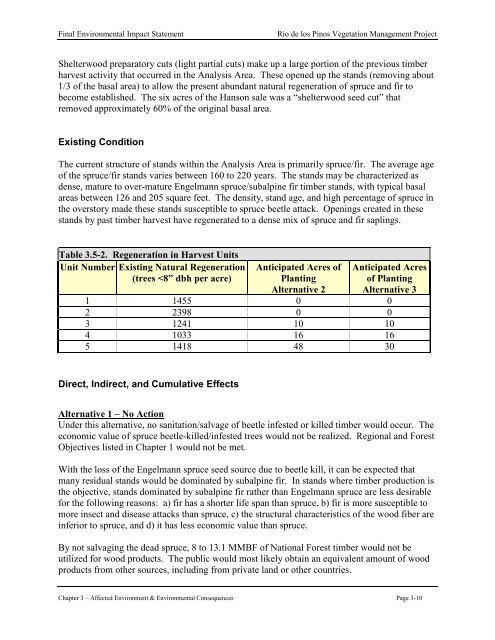Final Environmental Impact Statement Rio de los Pinos Vegetation ...
Final Environmental Impact Statement Rio de los Pinos Vegetation ...
Final Environmental Impact Statement Rio de los Pinos Vegetation ...
Create successful ePaper yourself
Turn your PDF publications into a flip-book with our unique Google optimized e-Paper software.
<strong>Final</strong> <strong>Environmental</strong> <strong>Impact</strong> <strong>Statement</strong> <strong>Rio</strong> <strong>de</strong> <strong>los</strong> <strong>Pinos</strong> <strong>Vegetation</strong> Management Project<br />
Shelterwood preparatory cuts (light partial cuts) make up a large portion of the previous timber<br />
harvest activity that occurred in the Analysis Area. These opened up the stands (removing about<br />
1/3 of the basal area) to allow the present abundant natural regeneration of spruce and fir to<br />
become established. The six acres of the Hanson sale was a “shelterwood seed cut” that<br />
removed approximately 60% of the original basal area.<br />
Existing Condition<br />
The current structure of stands within the Analysis Area is primarily spruce/fir. The average age<br />
of the spruce/fir stands varies between 160 to 220 years. The stands may be characterized as<br />
<strong>de</strong>nse, mature to over-mature Engelmann spruce/subalpine fir timber stands, with typical basal<br />
areas between 126 and 205 square feet. The <strong>de</strong>nsity, stand age, and high percentage of spruce in<br />
the overstory ma<strong>de</strong> these stands susceptible to spruce beetle attack. Openings created in these<br />
stands by past timber harvest have regenerated to a <strong>de</strong>nse mix of spruce and fir saplings.<br />
Table 3.5-2. Regeneration in Harvest Units<br />
Unit Number Existing Natural Regeneration<br />
(trees
















